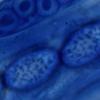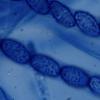
19-02-2016 23:38
 Bernard CLESSE
Bernard CLESSE
Bonsoir à tous,Voici ce que je pense être un Orb

19-02-2016 22:09
 Bernard CLESSE
Bernard CLESSE
Je suppose que vous le connaissez mais comme on ne

16-02-2016 21:31
François BartholomeeusenHi all,Found on dead stalk of Rubus lying on the g

19-02-2016 00:05
Olsson JanFound these on fallen twigs of Fraxinus. Is it pos

16-02-2016 17:29
 Blasco Rafael
Blasco Rafael
Hola, he encontrado esta muestra en estiercol de c

19-02-2016 10:42
 Stoykov Dimitar
Stoykov Dimitar
Hi, Dear Friends,Here are the stromata and spores
Scutellinia cf. balansae from Ethopia
Andreas Gminder,
31-12-2019 10:17
 Dear all,
Dear all,reviewing my collections from Ethiopia, we also came across some Scutellinia collections. And aready the first one poses problems to us.
Spores have an ornamentation a bit comperable to S. scutellata, by confluent warts and plaques of different shape, but is coarser and higher as in S. scutellata. Hairs at the margin multifurcate and very long, up to 1600 (-2000 µm), whereas on the flanks they are remarkably shorter and only up to 150-200 µm. Attention: the measures for hair width has to be taken x2,5 (values were in 400x magnification ...)
See attached fotos and scetch (drawing by Sylvie).
It would be nice to have an opinion from the experts :-)
all the best and a happy New Year to you,
Andreas and Sylvie
Andreas Gminder,
02-01-2020 11:10

Re : Scutellinia cf. balansae from Ethopia
Hello,
nobody of the Scutellinia experts any idea?
best wishes,
Andreas
nobody of the Scutellinia experts any idea?
best wishes,
Andreas
Malcolm Greaves,
03-01-2020 01:13
Re : Scutellinia cf. balansae from Ethopia
Happy New Year Andreas.
I suspect that like most of the forum members we have not been lucky enough to visit such exotic places so even those of use with some experience of this group will not have come across S balansae in the flesh. We then fall back on the description provided by Schumacher and individual papers like Cantrell and Hanlin. Your find has longer hairs and narrower spores than they describe for S balansae. Unfortunatelly I am unable to suggest anything better.
Mal
Andreas Gminder,
03-01-2020 11:11

Re : Scutellinia cf. balansae from Ethopia
Dear Mal,
thank you for taking the time nevertheless.
I know that travelling in tropic regions becomes more and more regular at least in the people dealing with agarica and polypores, andso I had the hope that people here are also may be experienced in speices form these areas. And I had the idea that may be someone might say that the spore ornamentation looks like immature (though I don't think it is) or similar comments, as I'm really unexperiemced with operculate ascomycetes and Scutellinia was always a genus I have difficulties with ....
all the best,
Andreas
thank you for taking the time nevertheless.
I know that travelling in tropic regions becomes more and more regular at least in the people dealing with agarica and polypores, andso I had the hope that people here are also may be experienced in speices form these areas. And I had the idea that may be someone might say that the spore ornamentation looks like immature (though I don't think it is) or similar comments, as I'm really unexperiemced with operculate ascomycetes and Scutellinia was always a genus I have difficulties with ....
all the best,
Andreas
Malcolm Greaves,
03-01-2020 17:32
Re : Scutellinia cf. balansae from Ethopia
Andreas
Benat always recommended studying spores that had been ejected. The ornamentation can sometimes become more prominent when ejected but can on occasions become less so and the sizes are more consistent.
Mal
Benat always recommended studying spores that had been ejected. The ornamentation can sometimes become more prominent when ejected but can on occasions become less so and the sizes are more consistent.
Mal
Andreas Gminder,
03-01-2020 23:57

Re : Scutellinia cf. balansae from Ethopia
Hello Mal,
yes, but that is not possible in the tropics usually.
best wishes,
Andreas
yes, but that is not possible in the tropics usually.
best wishes,
Andreas
Nicolas VAN VOOREN,
05-01-2020 18:11

Re : Scutellinia cf. balansae from Ethopia
Andreas,
Based on the literature I consulted (except the Gamundi's paper published in 1956), the spore
ornamentation of S. balansae seems a bit different. In your collection the warts are more coalescent and lower.
No other idea.
Based on the literature I consulted (except the Gamundi's paper published in 1956), the spore
ornamentation of S. balansae seems a bit different. In your collection the warts are more coalescent and lower.
No other idea.


